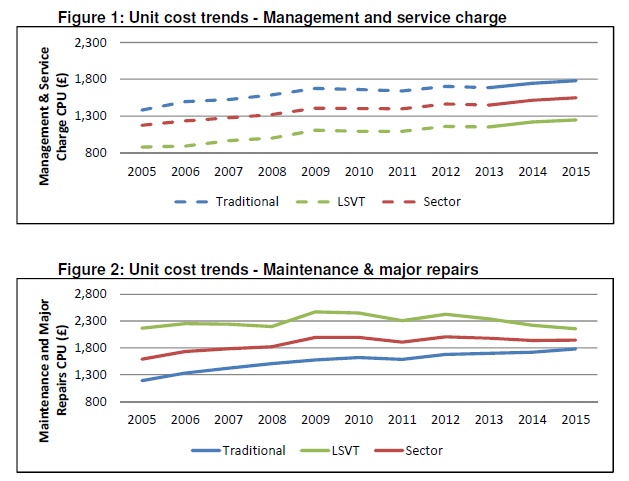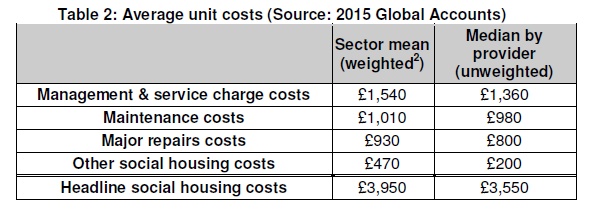HCA: sector must deliver 'step-change' in operating efficiency
The English housing association sector will need to deliver a ‘step-change’ in its operating efficiency over the next five years, according to latest in-depth analysis by the regulator.
The Homes and Communities Agency (HCA) also confirmed it will ‘increasingly challenge registered providers on their approach to efficiency as part of its regulation of Value for Money (VfM)’ and via its in-depth assessments (IDAs).
Where the regulator does not have sufficient assurances, it will ‘reflect this conclusion in the provider’s published governance grade’.
The plans were first mooted publicly at the Social Housing Annual Conference in November 2015, with further detail set out at the Social Housing Finance Conference last month.
The latest HCA costs analysis - which follows similar reports in 2011 and 2012 - confirms that geography and scale of association have ‘no material bearing’ on cost efficiency.
Against a backdrop of an increase in merger activity - including between the largest in the sector - the findings are somewhat inconclusive when it comes to economies of scale. There was no significant evidence of a clear relationship between scale of a provider and lower costs. But it also says the lack of evidence for economies of scale ‘does not necessarily mean that they cannot be achieved or they are not being achieved by providers’.
The report - Delivering better value for money: Understanding differences in unit costs – is aimed at helping boards and executives ‘further understand the main drivers of costs and ensure appropriate strategies are in place to maximise VfM and meet their objectives of investing in new and existing homes and delivering quality services to tenants’.
While the regulator has sent a summary of the findings for each association to that respective organisation, it has not published a breakdown of findings.
The analysis can be seen in the context of the 1 per cent, four-year social and affordable rent reduction, and most providers forecasting that they will reduce the cost of managing and maintaining their existing properties betwen 2016 and 2020.
Overall, providers are forecasting making greater cost savings over the coming years, with the headline social housing cost per unit forecast to decrease by 7 per cent in absolute terms.
The sector has reduced its headline social housing cost per unit in real terms over the last five years - largely due to the cost of maintenance and major repairs falling through the near completion of the Decent Homes programme they are forecasting making materially greater cost savings by 2021.
However, the results show the sector also needs ‘to significantly increase its operating efficiency over the next five years’.
Mean major repairs cost per unit is forecast to decrease by 10 per cent from £1,032 in 2016 to £928 in 2020, equivalent to a 16 per cent reduction in real terms. Over the same time period planned management and service cost per unit decreases by 5 per cent from £1,721 to £1,629, a 12 per cent real term reduction.
The HCA says this means that understanding what drives these costs and the scope for making savings without risk to the delivery of organisational objectives, core services to tenants, or the long term sustainability of the business, is vital.
Current costs
Median headline social housing costs were £3,550 per unit in 2015. This is made up of management and service charge costs, maintenance, major repairs and other social housing costs.
However, the regulator’s analysis found significant cost variation across the sector, with the lower and upper quartiles of headline unit costs being £3,200 and £4,300 respectively, and a minority of providers - mainly supported housing specialists - with headline unit costs in excess of £10,000.
Around 50 per cent of the variation in unit costs can be explained by key measured factors included in its regression analysis, such as the provision of supported housing and housing for older people, the area of operations, and large scale voluntary transfer (LSVT) status.
However, around 50 per cent of the variation in costs cannot be explained by ‘observable factors’.
It said: ‘Some of this unexplained variation is likely to be explained by factors that cannot be measured systematically by the available data, for example there is no systematic information on stock condition.
‘Nonetheless, some of the unexplained differences between providers are likely to be due to variations in operating efficiency.
‘If controllable variations in efficiency could be identified and reduced, then this could unlock additional resource to invest in the achievement of providers’ key objectives such as new housing supply and regeneration activity.’
Economies of scale?
The HCA said the regression analysis (see below) is a powerful tool to test the evidence that average costs vary with measured factors, but is not a complete model of costs and is not being used to determine what a ‘correct’ cost should be for each provider.
‘Some important cost drivers - such as service levels or stock condition – simply cannot be measured from the available data. Therefore, the lack of evidence for economies of scale does not necessarily mean that they cannot be achieved or they are not being achieved by providers.
‘It is possible that economies of scale are achievable, but may not be being delivered in practice.
‘However, it is also theoretically possible that efficiency gains are reflected in higher service levels or better stock condition, which weakens the statistical link between unit costs and size.
‘As providers grow, it is important that boards understand whether they are making the most of any opportunities for greater efficiency that expansion could present.’
In depth assessment
The regulator said it considers VfM as an integral part of providers’compliance with the economic standards via its IDA.
The IDA reviews will consider how a provider is maximising the return on its assets and how it makes decisions on the use of resources to maximise delivery of its objectives.
The regulator said it will use a range of cost data, including those derived from the provider’s accounts and forecasts.
As part of this assessment, the regulator will specifically seek assurance that providers understand unit costs.
‘Where data identifies that a provider has unusually high costs, the regulator will seek assurance that the provider understands why this is the case, whether this is the result of an informed business decision and, if not, its plans to reduce costs or improve outcomes,’ it said.
‘Where the regulator does not have sufficient assurance that this is the case, it will reflect this conclusion in the provider’s published governance grade.’
Fiona MacGregor, executive director of regulation at the HCA, said savings being forecasted between now and 2020 to offset the impact of cuts in social rents ‘are significantly greater than anything that the sector has achieved in recent years’.
‘However, our analysis shows a significant variation in costs between different providers, only half of which can be explained by observable factors,’ she said.
While boards will need to understand the costs of running their businesses and how they differ from their peers, providers will need an ‘intense focus on efficiency’.
She added: ‘We regard a focus on VfM as a leading indicator of good governance and it will therefore continue to be a major focus for the regulator over the coming years.’
Julian Ashby, chair of the regulation committee, has written to the chairs of all large registered providers to draw their attention to the new analysis and emphasise the importance that the regulator places on VfM.
Regression analysis
The regression analysis approach aims to understand how variations in headline social housing costs per unit might be explained by measured factors. Analysis is based on a panel dataset of cost and contextual information for provider entities with more than 1,000 units for 2005 to 2015 inclusive.
The HCA says a hypothetical ‘baseline’ provider - with 100% general needs properties, traditional status, with all units meeting the Decent Homes standard, and operating in an area with mean average wages and median deprivation - might be expected to have a cost of £3,300 per unit.
Around 50% of the variation in headline social housing costs per unit can be explained by the following key factors, ordered by relative importance, and holding all other factors constant:
- Supported housing (not including housing for older people) – each unit is associated with costs of £10,800 above general needs properties. This is likely to be associated with the high support costs, and a broader scope of activities undertaken by organisations with a specialised focus. The precise estimate of associated costs is sensitive to the inclusion or removal of more specialised supported housing organisations, with model estimates varying from £8,400 to £14,000 per unit. There is likely to be considerable diversity with the cost associated with each supported housing unit in the sector, for example by the client group and the level of service supplied.
- Regional wages – providers in London have costs of £1,900 per unit above those in the North East. Considering all factors, the difference in costs is broadly proportionate to the difference in average regional administrative and construction wages.
- Stock transfers – stock transfers providers have costs of £1,500 per unit higher than traditional providers in years 1-6 post-transfer. This gap narrows to £300 per unit for years 7-11, and disappears after 12 years.
- Housing for older people - each unit is associated with costs of £1,800 above general needs units.
- Neighbourhood deprivation – provider operating in neighbourhoods ranked in the 1% most deprived according to the Index of Multiple Deprivation have costs on average £500 per unit higher than average4. This could be associated with a range of factors, including more extensive regeneration and community initiatives, higher voids and turnover, and potentially greater crime and anti-social behaviour.
- Decent Homes – bringing a property to Decent Homes Standard is associated with additional costs of £8,800. The limited residual non- decent stock in the sector means this is now only an important factor for a small minority of providers.
RELATED


